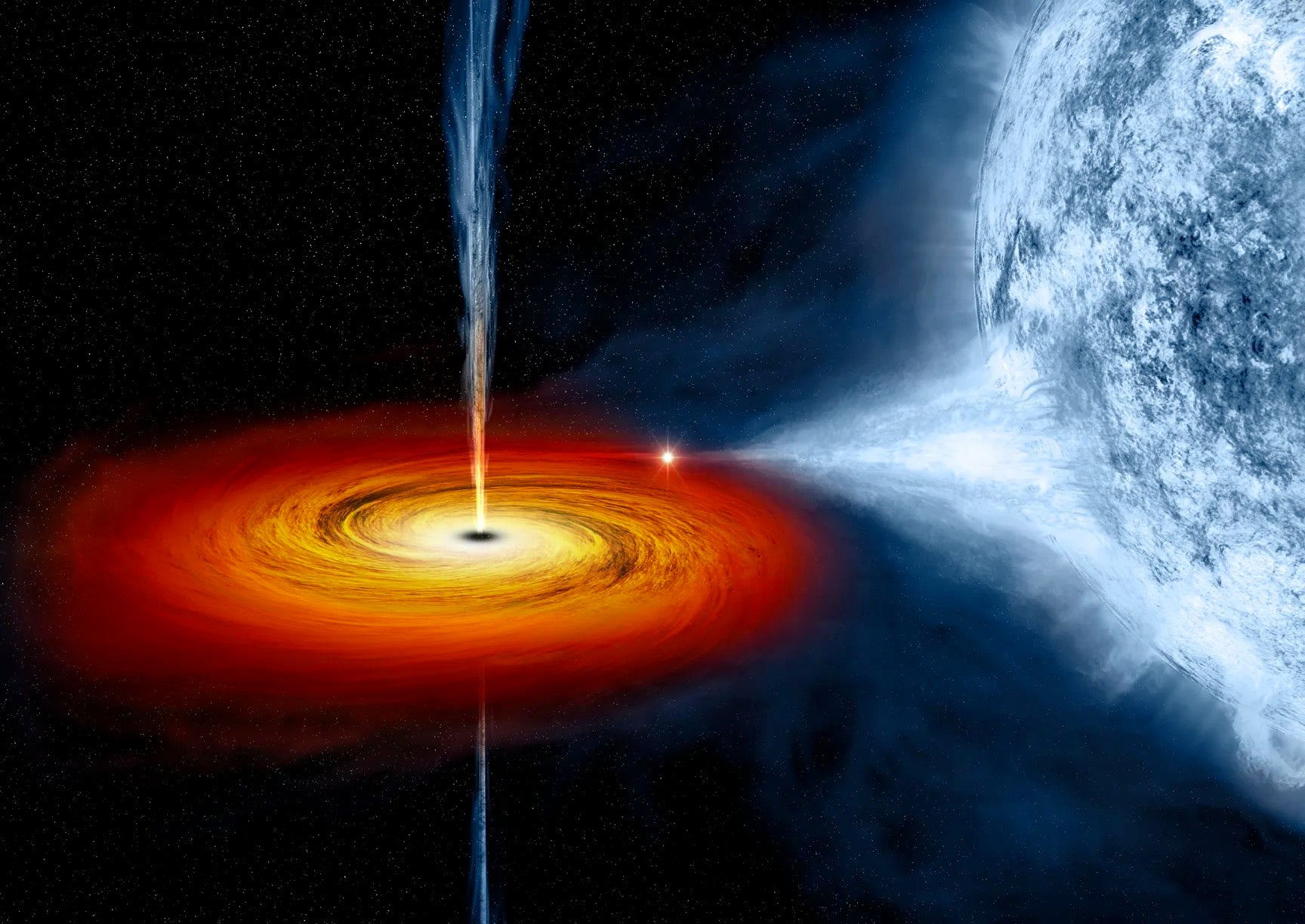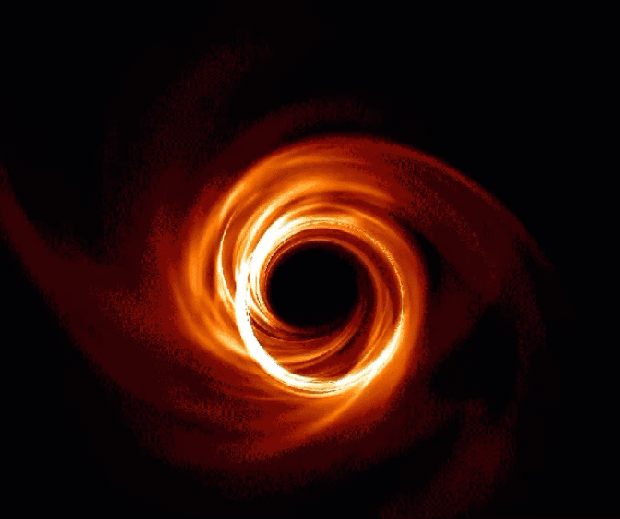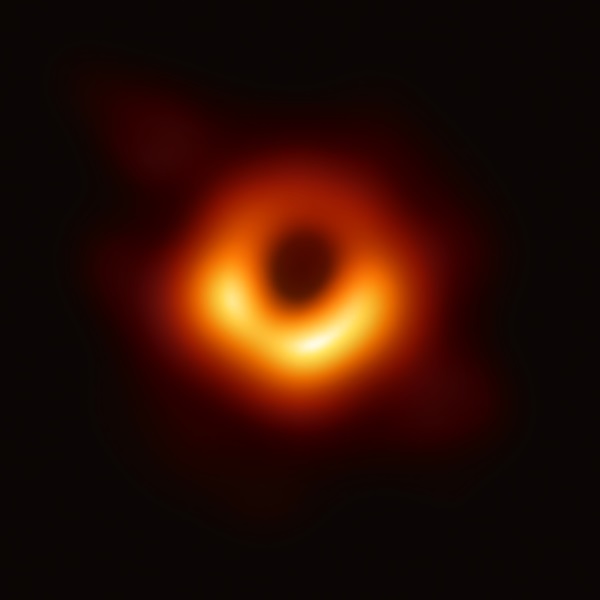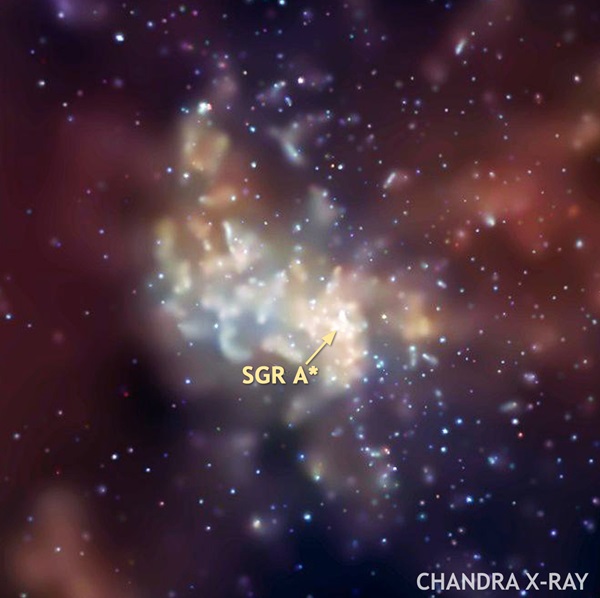
While we know a lot about black holes, they still remain as one of the greatest mysteries in the universe. So let’s dive in — not literally – to answer all your burning questions about these cosmic enigmas.
First, the basics. A black hole is a region of universe where gravity is so outrageously strong that nothing, not even light, can escape. Once something enters a black hole by crossing an invisible boundary known as the event horizon, it can never leave. At the center of a black hole sits the singularity, where the extreme gravitational forces reach to infinity, crushing everything into an infinitely tiny point.
How were black holes discovered?
Astronomers did not first discover black holes out in the universe. Instead, theoretical physicists found them hiding in the equations of Einstein’s general theory of relativity. In 1915 Einstein published his theory, which was a new and improved way to understand the force of gravity. Just a few months later the German physicist Karl Schwarzschild wrote Einstein a letter from the trenches of World War I where, in his free time, he had found the exact solution needed to describe the very common situation of the gravitational environment of a spherical ball of mass, like the gravity of the Sun in the solar system.

While Schwarzschild’s solution was immediately useful, it did contain a strange pathology. At a very specific distance from the center of the massive object, the math went haywire. His fellow theorists didn’t quite know what to make of this, but since this special distance was very small, it didn’t really impact the utility of Schwarzschild’s solution.
But as the decades went by, that special distance continued to be an itch that theorists just couldn’t scratch. Eventually physicists realized that this distance wasn’t just a mathematical curiosity. If you could somehow crush all the matter of an object below this special distance, then the force of gravity would overwhelm every other force of nature, causing the object to catastrophically collapse without end.
This special distance is now known as the event horizon, aka the Schwarzschild radius.
Who named black holes?
It wasn’t until 1968 that black holes got their name, thanks to physicist John Wheeler, who argued that black holes really do exist in the universe. Other astronomers argued that their strange properties were instead a sign that we were misunderstanding gravity, and that general relativity is incomplete.
The debate was settled in 1971 when astronomers confirmed the existence of an intense source of X-ray radiation known as Cygnus X-1. The astronomers got a lock on the size and mass of the X-ray source, and whatever it was, it was far smaller and far denser than any other known astronomical object. The only thing that fit the bill was a black hole.
The astronomers couldn’t see the black hole itself, because light does not escape them, but instead were observing the light emitted by matter as it crammed itself below the event horizon – its final deathly screams of light before it plunged itself into the inky blackness of the hole itself.
What’s inside a black hole?
I have to start this answer with a small caveat: we don’t know for sure what’s beneath the event horizon of a black hole, because we cannot access these regions of the universe. Their interiors really are locked away from our view forever. But we can make a good guess based on our understanding of relativity, which is probably a rather good guess considering that it’s through relativity that we discovered black holes in the first place.
There’s not much to the interior of a black hole. Just all the stuff that has ever fallen through the event horizon, quickly spiraling its way to the center. That center is the singularity, the real heart of the black hole. According to relativity the singularity is a region of infinite gravity, but we know this is incorrect. Our understanding of relativity is incomplete, because we have not yet been able to reconcile relativity with quantum mechanics, which is the physics of the smallest objects in the universe. In other words, the presence of the singularity is a sign that we do not understand gravity at extremely small scales. A better, quantum theory of gravity will hopefully solve the riddle, but as for right now we can only say that we’re not sure what happened at the center of a black hole.
How are black holes formed?

We know of only one sure-fire method for building black holes, and that’s through the death of a massive star. When a star at least eight times larger than the Sun nears its end, it forms a core of solid iron and nickel. The rest of the star, being rather massive, tries to gravitationally collapse onto this core, but it just bounces off of it. This bounce leads to two immediate, and catastrophic, effects. One, the star explodes in a spectacular supernova explosion, one of the most powerful events in the universe.
Second, the force of the bounce can overwhelm the core, causing it to collapse on its own. This triggers the formation of a black hole with the mass a few times that of the Sun.
However, there might be other, more exotic, ways to build black holes. In the extremely early universe, less than a second after the big bang, random patches of the universe may have achieved absurdly high densities, causing small black holes, each no bigger than a baseball, to simply appear. These “primordial” black holes would have flooded the universe, and presumably are whizzing around even today.
Black holes may have also formed before the appearance of the first stars, A few hundred million years after the big bang, gigantic clumps of matter may have directly collapsed into a black hole, skipping the whole star formation part. These black holes would be huge, starting out with a mass of hundreds or thousands of times that of the Sun.
Are black holes really ‘black’?
Confusingly, black holes aren’t exactly 100 percent black. But you can’t blame anyone for sticking to the name. After all, “grey holes” don’t exactly evoke the same sense of awe and mystery, and by the time we discovered that black holes aren’t completely black, the name had already been around for decades.
General relativity says that black holes are totally black, and that nothing escapes. But in 1976 famed astrophysicist Stephen Hawking discovered that strange quantum effects operating at the event horizons can cause black holes to slowly emit radiation. For a typical black hole, it will only emit around one photon every year of Hawking radiation. But given enough time, the emission of the radiation will cause the black hole to lose mass and eventually disappear altogether.
Crucially, this radiation is thermal, meaning that it’s totally random, and it does not carry any information about what fell into the black hole. This leads to the Black Hole Information Paradox, a major unsolved problem in modern physics: since information cannot be created or destroyed, where does the information go when the black hole evaporates? The first person to successfully answer this question will almost certainly win a Nobel prize.
Has anyone gone into a black hole?
No, and it wouldn’t be a fun trip. For small black hole, the extreme gravity would stretch you out well before you reach the event horizon in a process cheekily known as “spaghettification.” For large black holes, you can pass through the event horizon unharmed. But once you cross that invisible boundary, you’ll never escape, and you’ll be doomed to reach the singularity, where you will be crushed into oblivion.
What’s the closest black hole to Earth?

There are likely hundreds of millions of black holes wandering the Milky Way galaxy, but the nearest known one is called Gaia BH1. Discovered in 2022 by the European Space Agency’s Gaia mission (hence the name), the black hole sits 1,560 light-years away. There are probably black holes closer to us, but these objects are exceptionally hard to detect. We can only see black holes when they influence their surroundings, like in the case of Cygnus X-1, or when they merge together and release gravitational waves.
How big are black holes?

Most black holes are known as stellar-mass, meaning that they have a mass of a few to a few dozen times that of the Sun. These absolutely litter every single galaxy, as they are the product of deaths of massive stars.
But there are bigger ones. Small black holes can grow by merging together and by swallowing new material. These giants, known as supermassive black holes, typically slink their way to the centers of galaxies. The black hole at the center of the Milky Way, known as Sagittarius A*, weighs around 4.5 million solar masses. The record holder, however, is a true beast. It’s appropriately called TON 618, and it weighs a whopping 66 billion solar masses. Thankfully it sits over 18 billion light-years away from Earth, and so we don’t ever have to confront that enormity up close and personal.
Paul M. Sutter is a theoretical cosmologist, NASA advisor, and a research professor at the Institute for Advanced Computational Science at Stony Brook University and a visiting professor at Barnard College, Columbia University.









